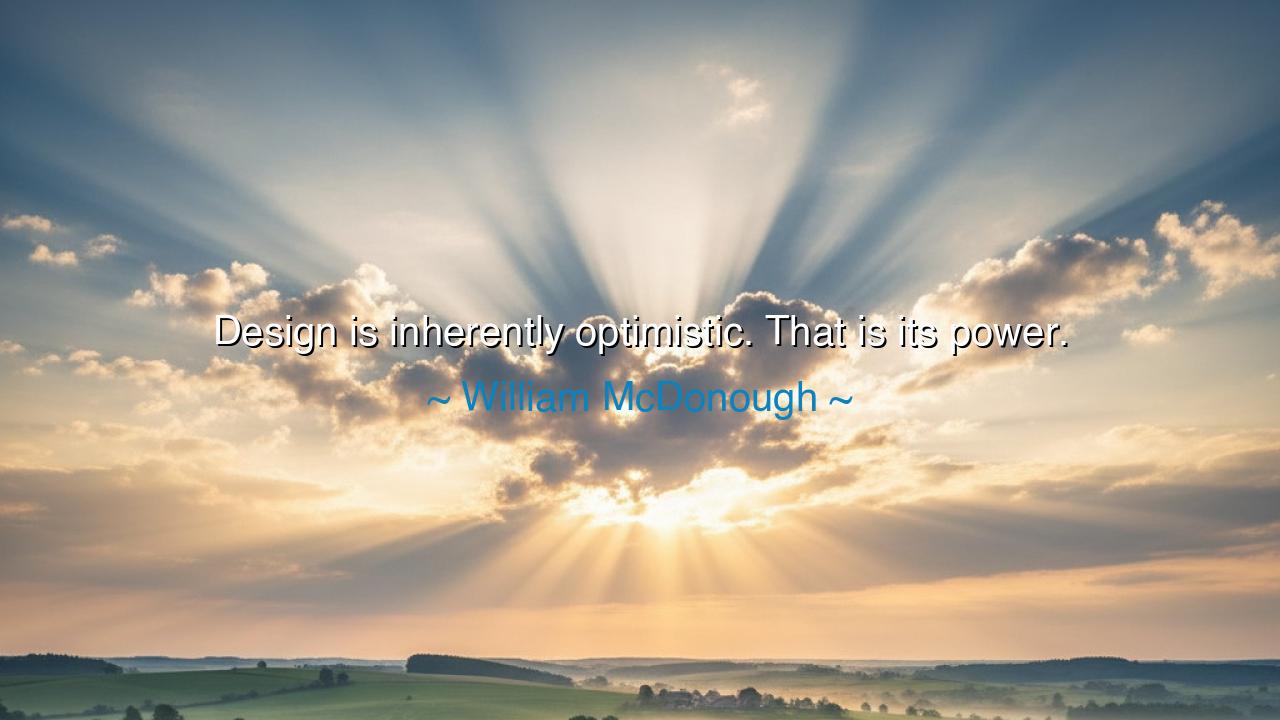
Design is inherently optimistic. That is its power.






“Design is inherently optimistic. That is its power.” – William McDonough
In these radiant and enduring words, William McDonough, the architect and visionary of sustainable design, speaks of a truth both profound and eternal — that design is not merely the act of shaping materials or making things beautiful, but an act of hope. When he declares that design is “inherently optimistic,” he is saying that every act of creation is also an act of faith in the future. To design is to imagine what could be, not to surrender to what is. It is to believe that human hands and minds can bring forth harmony where there is chaos, renewal where there is decay, and beauty where there is emptiness. This, McDonough teaches, is the quiet power of design — it looks upon the broken and envisions it whole again.
Born of the modern age yet guided by ancient principles, McDonough’s philosophy of design is steeped in reverence for life. He is best known for his concept of “Cradle to Cradle” design — a way of making things that does not destroy, but restores. He believes that design can be regenerative, that every building, object, or system can serve both people and planet. It is from this vision that his words arise. In a world weary from destruction, he reminds us that to design at all — to plan, to create, to innovate — is to stand against despair. Every blueprint is a declaration of belief in possibility. The act of design, in its truest form, is an act of love for what might be.
The ancients would have understood him well. When Daedalus built the labyrinth of Crete, he was not merely crafting walls of stone — he was weaving order from confusion, a symbol of humanity’s gift for creation in the face of the unknown. When Vitruvius, the Roman architect, wrote of proportion and harmony, he spoke of balance not just in structure but in the spirit. For design, even then, was seen as a reflection of the cosmos, of divine order expressed through human ingenuity. The artist, the architect, the craftsman — all were, in their way, bearers of hope. To design something better is to believe that the world can indeed be better.
McDonough’s words rise also from the soil of modern struggle — an age where design has too often been used to exploit rather than uplift. Factories, cities, technologies — all built without care for the earth that sustains them — have brought both progress and peril. Yet McDonough refuses to despair. His optimism is not naive, but courageous. He believes that the same creative force that built the modern world can also heal it. To him, design is not the servant of greed, but the instrument of renewal. To design a sustainable city, a product that gives more than it takes, or a building that breathes like a tree — this is the optimism of the maker, who looks upon the future not with fear, but with purpose.
There is a story told of Brunelleschi, the Renaissance architect who, against all doubt, designed the great dome of Florence. The city had dreamed of such a dome for generations, yet no one knew how to build it. It seemed impossible. But Brunelleschi, with faith in his vision, dared to find a way. His design defied gravity, reason, and fear — and when the dome rose, it became not only a triumph of engineering but a testament to human belief in the possible. His act of design was pure optimism given form in brick and stone. And so it is with every act of true creation: to design is to trust that the unseen can one day stand before us, radiant and real.
This is what McDonough means when he says, “That is its power.” The power of design lies not merely in the things it produces — the chair, the building, the city — but in the spirit it awakens. It reminds humanity that creation is stronger than destruction, that thought is stronger than circumstance. Design is the bridge between imagination and existence; it is the answer humanity gives to despair. Even when the world trembles, even when systems crumble, design whispers, “We can build again.”
So, my child of creation, take this teaching to heart: be a designer in all that you do. Not only in the crafting of objects, but in the crafting of your life, your community, your world. Look upon what is broken, and dare to imagine it whole. When others see decay, see potential. When others surrender, begin again. Let your every act — your words, your work, your kindness — be a form of design, shaping the future with care and courage. For to design is not to decorate the world, but to redeem it.
And thus, remember always: “Design is inherently optimistic.” It is the voice of the creator that says, “The best is yet to come.” That optimism — that faith in renewal — is the true power of design, and within it lies the power of humankind itself.






AAdministratorAdministrator
Welcome, honored guests. Please leave a comment, we will respond soon